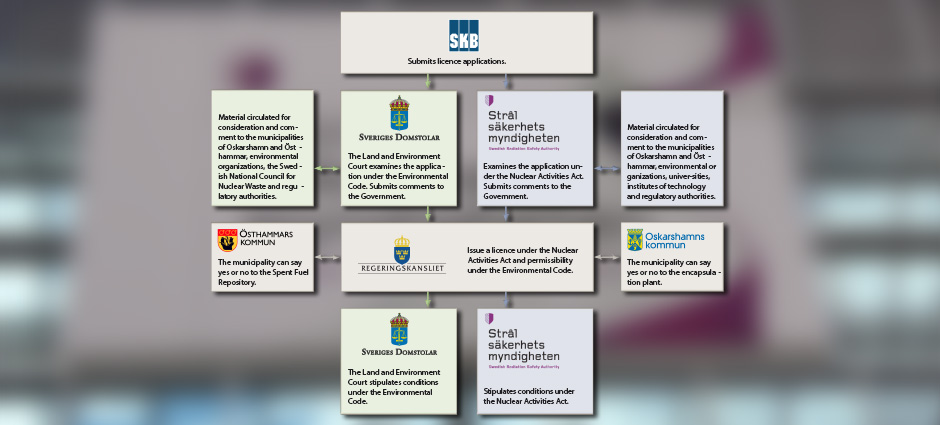Siting and licensing process
In Sweden the efforts to find a suitable and acceptable location for radioactive waste started back in the mid-1970s, almost 50 years ago.
It is SKB International’s objective to support our radioactive waste management sister organisations and countries in managing the process to find a site for their radioactive waste. However, it must be acknowledged that finding a suitable geological formation where a well functioning infrastructure can be established and that is accepted by the local community does take time, often a lot of time.
SKB learned a hard-earned lesson from its experiences with political and local community issues during the long process, until, in 2008, the company finally decided on the site to be used in the licence application (submitted to the government in 2011). The experiences gained by SKB can be seen as a methodology, a methodology that now will be part of an international recommendation and support document from the IAEA.
SKB used a stepwise process, starting with geological surveys, literature studies together with early pre-siting studies, to increase its knowledge of the bedrock conditions important for the long-term safety of a repository. This was undertaken on a national scale.
In our RD&D programme 1992, SKB presented and gained government support for a siting process, based on the execution of several feasibility studies, while also communicating siting criteria. The iteration with the governing authorities was initiated and during this time, for example, the extreme importance of the environmental impact assessment (EIA) was noted. This can also be seen as the start of the licensing process in Sweden.
Siting factors that were included in the feasibility studies were:
- Safety
Siting factors of importance for the long-term safety of the repository - Technology
Siting factors of importance for the construction, performance and safe operation of the repository and its transportation system - Land and environment
Siting factors of importance for land use and environmental impact - Societal aspects
Siting factors connected to societal considerations and community impact
In the feasibility study, the general conditions of the bedrock in Sweden were investigated, focusing especially on the conditions that must be avoided for a repository, for example:
- Highly heterogeneous and difficult-to-interpret bedrock conditions
- Rock types of interest for mineral extraction or other exploitation
- Known major deformation zones and neotectonic faults
- Pronounced discharge areas for groundwater
- Abnormal groundwater chemistry
The feasibility studies were followed by the site investigation phase and it was agreed between the government and implementer that these studies should be conducted for at least two specific sites. The site investigations involved vast geological investigations, including:
- Geological surface mapping,
- geophysical surveys,
- core mapping,
- geophysical logging,
- hydraulic tests,
- groundwater sampling,
- stress measurements etc.
Based on the site investigations a single and very specific site was selected and communicated.
Using data (data management is crucial) from the site investigation and additional modelling and some new data sets, the site descriptive model (SDM) was refined and used in the post-closure safety assessment. The findings, in compliance with the regulations, were published as part of the licence application for the final repository in 2011.
The licence application process in Sweden has been time-consuming and SKB has gained experience from the legal processes, both with respect to the nuclear regulatory authority and the environmental court. Fulfilling several sets of regulations is a challenge, but SKB accomplished this successfully and 11 years after the original application was submitted, SKB received government approval for the KBS-3 final repository system for spent nuclear fuel (2022-01-27).
SKB is responsible for the entire back-end of radioactive waste management in Sweden. This includes not only the spent nuclear fuel, but all radioactive waste. In Sweden, SKB has operated a final repository for short-lived radioactive waste since 1988. This repository needs to be extended and a licence application, including a safety assessment for post-closure safety, has been submitted and has also received approval by the government (Dec. 2021).
The third and last final repository needed as part of Sweden’s nuclear waste management programme will take care of the long-lived radioactive waste. This repository has not yet been located or designed in detail. However, an important first iteration has been made: a proposed design, located in a generic bedrock, has been evaluated, documented and communicated. The process has been started and experiences from earlier site selection and licence applications have been extensively incorporated in the process to move the project forward.
SKB International has the unique opportunity to support radioactive waste organisations globally and make use of the experience and valuable knowledge gained from finished and ongoing processes towards site selection and licence application.
How we support you
Working together with sister organisations and acknowledging the differences between countries with regards to regulations and legal systems, geological and other technical factors, SKB International is the partner of choice to ensure an effective and low-risk process towards site selection and licence application.
